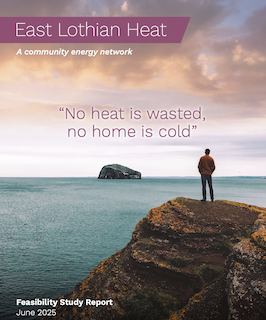East Lothian Heat is a visionary infrastructure project that has grown out of East Lothian Council’s Local Heat and Energy Efficiency Strategy (LHEES) that was published in October 2024. East Lothian Heat’s aim is to deliver clean, affordable heat across the Lothians by capturing local waste heat and renewable energy in a heat network, under a community-led, not-for-profit model. The project’s guiding vision is “a community where no heat is wasted and no home is cold,” reflecting our commitment to eradicate fuel poverty and use energy more efficiently.
A volunteer steering group of local experts and community leaders formed in 2024 to explore this opportunity, commissioning a professional feasibility study with support from charitable funds. This study, delivered by consultants Viegand Maagøe, has confirmed the technical and economic viability of a county-wide heat network, including detailed modeling of heat demands, capital and operating costs, heat distribution, and socio-economic impacts.
Early results are highly encouraging: even without subsidies, the proposed heat network could deliver heat at lower cost per unit than the leading low-carbon alternative (individual heat pumps). Moreover, an integrated regional approach – extending supply to neighbouring Edinburgh – further reduces costs for East Lothian consumers by leveraging economies of scale. These findings demonstrate that the East Lothian Heat Network can be both feasible and cost-competitive, unlocking local economic benefits, long-term price stability, and significant carbon reductions.
The recommended strategy is to implement the network in four phases over the coming decade, starting with a Phase 1 project centered on Musselburgh in western East Lothian and progressively expanding eastwards and into the wider region. Each phase will build momentum, connect major heat sources (from industrial waste heat to a new data centre and renewable sources), and deliver heat to homes, businesses, and public buildings. By Phase 4, the network would form a “heat transmission highway” spanning East Lothian and feeding into the Edinburgh heat system. This phased delivery allows early wins at local scale while laying the groundwork for a transformative regional heat infrastructure.
The project’s ownership and delivery model is evolving with a clear principle: to maximise community benefit and public value. International best practice shows that the most successful heat networks feature strong community or municipal ownership, ensuring affordable and reliable heat supply. In East Lothian’s case, a not-for-profit operating model is envisioned for the primary heat transmission network, so that any surplus value is reinvested or passed on as lower heat prices.
The project team is exploring models that emphasise community ownership and wealth building, such as cooperative and community-interest company structures, with the possibility of creating a regional community-owned energy company (provisionally referred to as “Lothian Community Energy”) to own and operate the network in the public interest (Note: This is an emerging concept outside the provided feasibility documents for future governance.). This approach would allow East Lothian Council, communities, and potentially regional partners to share ownership and governance, similar to the Danish heat networks owned by municipalities and operated on a commercial-but- not-profit-maximising basis.
Read the full Feasibility Study Report.

